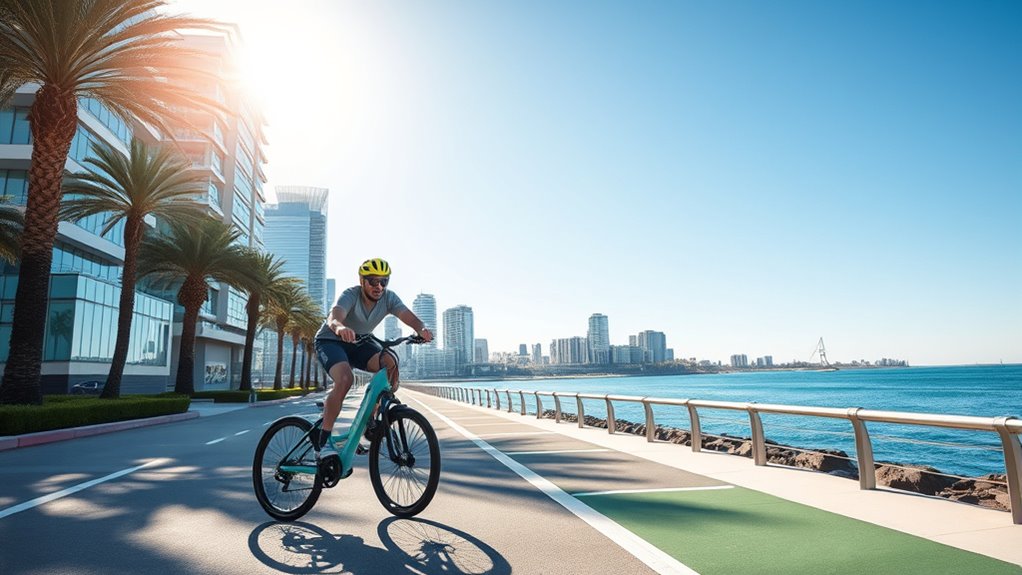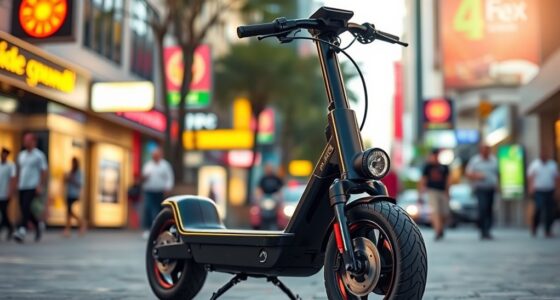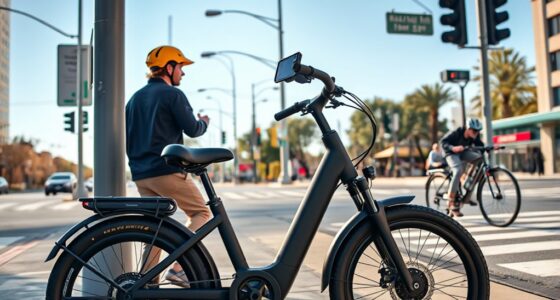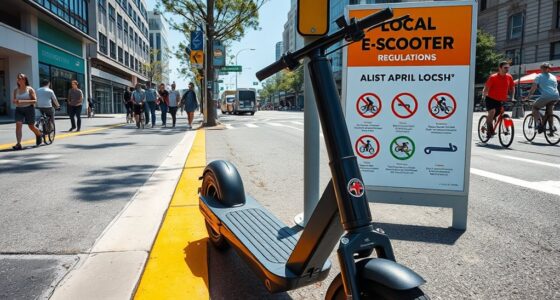In California, e-bike laws vary by class: Class 1 and 2 bikes are legal on most bike paths and streets, with speeds up to 20 mph, while Class 3 bikes can reach 28 mph but require riders to be at least 16 years old. Helmet use is advised for all riders. Always follow traffic laws and check local regulations to stay safe and compliant. Learn more about specific rules to ride confidently and responsibly.
Key Takeaways
- California classifies e-bikes into three types, with speed limits of 20 mph for Class 1 and 2, and 28 mph for Class 3.
- Riders must be at least 16 years old to operate Class 3 e-bikes; there’s no minimum age for Class 1 and 2.
- E-bikes are generally allowed on bike paths, lanes, and streets, but local restrictions may vary.
- Helmets are strongly recommended for all riders to ensure safety, regardless of age or e-bike class.
- Staying updated on local laws and regulations helps ensure legal and safe e-bike riding across California.
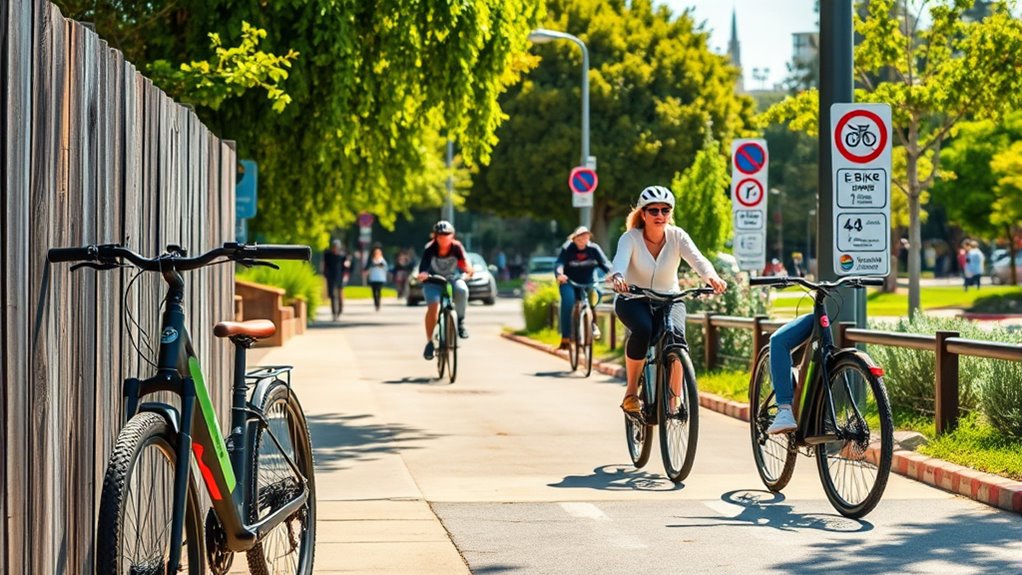
Are you wondering what the rules are for riding e-bikes in California? If you’re looking to enjoy this eco friendly commuting option, understanding the laws is essential for your safety and legal riding. California categorizes e-bikes into three classes based on their speed and features. Class 1 e-bikes are pedal-assist bikes that only provide assistance up to 20 mph. Class 2 models have a throttle and can reach speeds up to 20 mph without pedaling. Class 3 bikes are pedal-assist only and can go up to 28 mph. Knowing which class your e-bike falls into helps you stay compliant and ensures proper bike safety practices on the road or trail.
When it comes to age restrictions, California sets a minimum age of 16 for riding Class 3 e-bikes, which often operate at higher speeds. However, there’s no minimum age requirement for Class 1 and 2 e-bikes, but parents should always consider the rider’s maturity and ability to handle the bike safely. Wearing a helmet is strongly recommended for all e-bike riders, regardless of age, to promote bike safety and prevent injuries. Following traffic rules, signaling intentions, and being visible are key components of responsible riding, helping you avoid accidents and promote a safe environment for everyone. Remember, responsible e-bike use not only protects you but also fosters a positive image for eco friendly commuting and sustainable transportation.
California law permits e-bike riding on most bike paths, bike lanes, and streets, but restrictions may vary depending on local regulations. Some parks and trails may prohibit motorized bikes, so it’s wise to check the specific rules of your riding area. If you’re riding on sidewalks, ensure it’s allowed in your city, and always yield to pedestrians. Staying informed about where you can ride reduces the risk of fines and accidents, while also supporting bike safety initiatives. As e-bikes become more popular, local authorities are continuously updating regulations to balance rider convenience with safety concerns, so keeping up with current laws is always a good idea. Additionally, understanding the exponential growth of e-bike popularity can help riders advocate for safer and more inclusive cycling infrastructure.
Frequently Asked Questions
Are E-Bikes Allowed on California Mountain Trails?
You’re generally not permitted to ride e-bikes on California mountain trails, as trail e-bike regulations restrict e-bike access to protect natural resources and other trail users. Many mountain trails restrict e-bike access, especially on designated wilderness areas and certain public lands. Always check specific trail rules before riding, because access varies by location and management agency. Respect trail regulations to preserve trails and ensure a safe, enjoyable experience.
How Do E-Bike Laws Differ Between Cities in California?
Ever wondered how city rules vary for e-bikes? You’ll find that local regulations and enforcement practices differ across California. Some cities, like San Francisco and Los Angeles, have strict rules about where and how fast you can ride, while others are more lenient. Always check with your city’s specific laws before riding. Do you know if your area has unique e-bike restrictions? Staying informed helps you ride safely and legally.
Can I Ride an E-Bike on the Sidewalk Legally?
You shouldn’t ride your e-bike on the sidewalk because it can interfere with pedestrian safety. California law generally restricts e-bike use on sidewalks unless local ordinances permit it. Riding on the sidewalk may lead to fines or other penalties. To stay safe and legal, stick to bike lanes or streets and always watch out for pedestrians to guarantee their safety and avoid trouble.
Are E-Bikes Permitted on Public Transportation in California?
Riding an e-bike on public transportation in California is generally not permitted, but you can bring it along if it’s properly folded and meets the transit agency’s rules. Think of your e-bike as a guest that needs registration and parking regulations in check. Make sure it’s registered if required, and find designated parking spots. Always check specific transit policies to avoid surprises and ensure smooth travels with your e-bike.
What Are the Insurance Requirements for E-Bike Riders?
California doesn’t require specific insurance for e-bike riders, but it’s wise to have liability coverage to protect yourself. If you cause an accident, insurance can cover damages or injuries to others. Some personal auto insurance policies might extend coverage to e-bike use, so check with your provider. Without proper liability coverage, you could be personally responsible for any damages or injuries you cause while riding your e-bike.
Conclusion
Now that you know the speed limits, age requirements, and where you can ride your e‑bike, you’re ready to hit the roads responsibly. Follow the laws, stay safe, and enjoy the freedom your e‑bike offers. Respect the rules, protect yourself, and consider others on the trail. Ride smart, ride legal, and embrace the thrill of exploring California’s scenic routes—because when you ride responsibly, everyone benefits.
